I gave a talk at Glug London last week, where I discussed something that’s been on my mind at least since 2007, when I last talked about it briefly at Interesting.
It is rearing its head in our work, and in work and writings by others – so thought I would give it another airing.
The talk at Glug London bounced through some of our work, and our collective obsession with Mary Poppins, so I’ll cut to the bit about the Robot-Readable World, and rather than try and reproduce the talk I’ll embed the images I showed that evening, but embellish and expand on what I was trying to point at.
Robot-Readable World is a pot to put things in, something that I first started putting things in back in 2007 or so.
At Interesting back then, I drew a parallel between the Apple Newton’s sophisticated, complicated hand-writing recognition and the Palm Pilot’s approach of getting humans to learn a new way to write, i.e. Graffiti.
The connection I was trying to make was that there is a deliberate design approach that makes use of the plasticity and adaptability of humans to meet computers (more than) half way.
Connecting this to computer vision and robotics I said something like:
“What if, instead of designing computers and robots that relate to what we can see, we meet them half-way – covering our environment with markers, codes and RFIDs, making a robot-readable world”
After that I ran a little session at FooCamp in 2009 called “Robot readable world (AR shouldn’t just be for humans)” which was a bit ill-defined and caught up in the early hype of augmented reality…
But the phrase and the thought has been nagging at me ever since.
I read Kevin Kelly’s “What technology wants” recently, and this quote popped out at me:


Three billion artificial eyes!
In zoologist Andrew Parker’s 2003 book “In the blink of an eye” he outlines ‘The Light Switch Theory’.
“The Cambrian explosion was triggered by the sudden evolution of vision” in simple organisms… active predation became possible with the advent of vision, and prey species found themselves under extreme pressure to adapt in ways that would make them less likely to be spotted. New habitats opened as organisms were able to see their environment for the first time, and an enormous amount of specialization occurred as species differentiated.”
In this light (no pun intended) the “Robot-Readable World” imagines the evolutionary pressure of those three billion (and growing) linked, artificial eyes on our environment.
It imagines a new aesthetic born out of that pressure.
As I wrote in “Sensor-Vernacular”
[it is an aesthetic…] Of computer-vision, of 3d-printing; of optimised, algorithmic sensor sweeps and compression artefacts. Of LIDAR and laser-speckle. Of the gaze of another nature on ours. There’s something in the kinect-hacked photography of NYC’s subways that we’ve linked to here before, that smacks of the viewpoint of that other next nature, the robot-readable world. The fascination we have with how bees see flowers, revealing animal link between senses and motives. That our environment is shared with things that see with motives we have intentionally or unintentionally programmed them with.
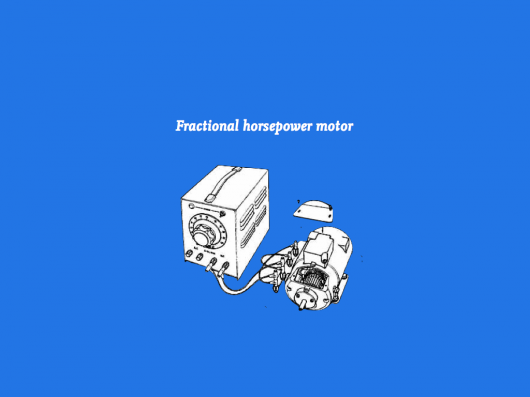

The things we are about to share our environment with are born themselves out of a domestication of inexpensive computation, the ‘Fractional AI’ and ‘Big Maths for trivial things’ that Matt Webb has spoken about this year (I’d recommend starting at his Do Lecture).
And, as he’s also said before – it is a plausible, purchasable near-future that can be read in the catalogues of discount retailers as well as the short stories of speculative fiction writers.
We’re in a present, after all, where a £100 point-and-shoot camera has the approximate empathic capabilities of a infant, recognising and modifying it’s behaviour based on facial recognition.


And where the number one toy last Christmas is a computer-vision eye that can sense depth, movement, detect skeletons and is a direct descendent of techniques and technologies used for surveillance and monitoring.
As Matt Webb pointed out on twitter last year:


Ten years of investment in security measures funded and inspired by the ‘War On Terror’ have lead us to this point, but what has been left behind by that tide is domestic, cheap and hackable.
Kinect hacking has become officially endorsed and, to my mind, the hacks are more fun than the games that have published for it.
Greg Borenstein, who scanned me with a Kinect at FooCamp is at the moment writing a book for O’Reilly called ‘Making Things See’.
It is a companion in someways to Tom Igoe’s handbook to injecting behaviour into everyday things with Arduino and other hackable, programmable hardware called “Making Things Talk”.
“Making Things See” could be the the beginning of a ‘light-switch’ moment for everyday things with behaviour hacked-into them. For things with fractional AI, fractional agency – to be given a fractional sense of their environment.
Again, I wrote a little bit about that in “Sensor-Vernacular”, and the above image by James George & Alexander Porter still pins that feeling for me.
The way the world is fractured from a different viewpoint, a different set of senses from a new set of sensors.
Perhaps it’s the suspicious look from the fella with the moustache that nails it.
And its a thought that was with me while I wrote that post that I want to pick at.
The fascination we have with how bees see flowers, revealing the animal link between senses and motives. That our environment is shared with things that see with motives we have intentionally or unintentionally programmed them with.
Which leads me to Richard Dawkins.
Richard Dawkins talks about how we have evolved to live ‘in the middle’ (http://www.ted.com/talks/richard_dawkins_on_our_queer_universe.html) and our sensorium defines our relationship to this ‘Middle World’
“What we see of the real world is not the unvarnished world but a model of the world, regulated and adjusted by sense data, but constructed so it’s useful for dealing with the real world.
The nature of the model depends on the kind of animal we are. A flying animal needs a different kind of model from a walking, climbing or swimming animal. A monkey’s brain must have software capable of simulating a three-dimensional world of branches and trunks. A mole’s software for constructing models of its world will be customized for underground use. A water strider’s brain doesn’t need 3D software at all, since it lives on the surface of the pond in an Edwin Abbott flatland.”
Middle World — the range of sizes and speeds which we have evolved to feel intuitively comfortable with –is a bit like the narrow range of the electromagnetic spectrum that we see as light of various colours. We’re blind to all frequencies outside that, unless we use instruments to help us. Middle World is the narrow range of reality which we judge to be normal, as opposed to the queerness of the very small, the very large and the very fast.”
At the Glug London talk, I showed a short clip of Dawkins’ 1991 RI Christmas Lecture “The Ultraviolet Garden”. The bit we’re interested in starts about 8 minutes in – but the whole thing is great.
In that bit he talks about how flowers have evolved to become attractive to bees, hummingbirds and humans – all occupying separate sensory worlds…
Which leads me back to…
 


What’s evolving to become ‘attractive’ and meaningful to both robot and human eyes?
Also – as Dawkins points out
The nature of the model depends on the kind of animal we are.
That is, to say ‘robot eyes’ is like saying ‘animal eyes’ – the breadth of speciation in the fourth kingdom will lead to a huge breadth of sensory worlds to design within.
One might look for signs in the world of motion-capture special effects, where Zoe Saldana’s chromakey acne and high-viz dreadlocks that transform here into an alien giantess in Avatar could morph into fashion statements alongside Beyoncé’s chromasocks…
Or Takashi Murakami’s illustrative QR codes for Louis Vuitton.
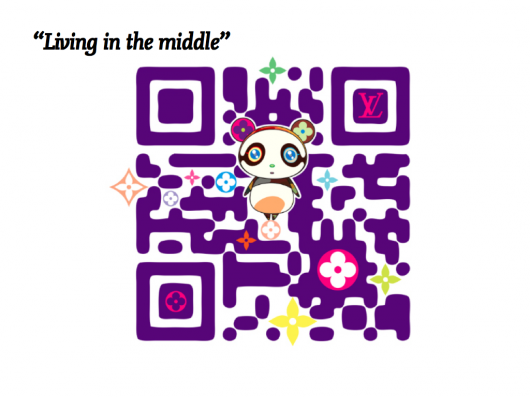

That a such a bluntly digital format such as a QR code can be appropriated by a luxury brand such as LV is notable by itself.
Since the talk at Glug London, Timo found a lovely piece of work featured by BLDGBLOG by Diego Trujillo-Pisanty who is a student on the Design Interactions course at the RCA that I sometimes teach at.
Diego’s project “With Robots” imagines a domestic scene where objects, furniture and the general environment have been modified for robot senses and affordances.
Another recent RCA project, this time from the Design Products course, looks at fashion in a robot-readable world.
Thorunn Arnadottir’s QR-code beaded dresses and sunglasses imagine a scenario where pop-stars inject payloads of their own marketing messages into the photographs taken by paparazzi via readable codes turning the parasites into hosts.
But, such overt signalling to distinct and separate senses of human and robots is perhaps too clean-cut an approach.
Computer vision is a deep, dark specialism with strange opportunities and constraints. The signals that we design towards robots might be both simpler and more sophisticated than QR codes or other 2d barcodes.
Timo has pointed us towards Maya Lotanʼs work from Ivrea back in 2005. He neatly frames what may be the near-future of the Robot-Readable World:
Those QR ‘illustrations’ are gaining attention because they are novel. They are cheap, early and ugly computer-readable illustration, one side of an evolutionary pressure towards a robot-readable world. In the other direction, images of paintings, faces, book covers and buildings are becoming ‘known’ through the internet and huge databases. Somewhere they may meet in the middle, and we may have beautiful hybrids such as http://www.mayalotan.com/urbanseeder-thesis/inside/
In our own work with Dentsu – the Suwappu characters are being designed to be attractive and cute to humans and meaningful to computer vision.
Their bodies are being deliberately gauged to register with a computer vision application, so that they can interact with imaginary storylines and environments generated by the smartphone.
Back to Dawkins.
Living in the middle means that our limited human sensoriums and their specialised, superhuman robotic senses will overlap, combine and contrast.
Wavelengths we can’t see can be overlaid on those we can – creating messages for both of us.
SVK wasn’t created for robots to read, but it shows how UV wavelengths might be used to create an alternate hidden layer to be read by eyes that see the world in a wider range of wavelengths.
Timo and Jack call this “Antiflage” – a made-up word for something we’re just starting to play with.
It is the opposite of camouflage – the markings and shapes that attract and beguile robot eyes that see differently to us – just as Dawkins describes the strategies that flowers and plants have built up over evolutionary time to attract and beguile bees, hummingbirds – and exist in a layer of reality complimentary to that which we humans sense and are beguiled by.
And I guess that’s the recurring theme here – that these layers might not be hidden from us just by dint of their encoding, but by the fact that we don’t have the senses to detect them without technological-enhancement.
I say a recurring theme as it’s at the core of the Immaterials work that Jack and Timo did with RFID – looking to bring these phenomena into our “Middle World” as materials to design with.
And while I present this as a phenomena, and dramatise it a little into being an emergent ‘force of nature’, let’s be clear that it is a phenomena to design for, and with. It’s something we will invent, within the frame of the cultural and technical pressures that force design to evolve.
That was the message I was trying to get across at Glug: we’re the ones making the robots, shaping their senses, and the objects and environments they relate to.
Hence we make a robot-readable world.
I closed my talk with this quote from my friend Chris Heathcote, which I thought goes to the heart of this responsibility.
There’s a whiff in the air that it’s not as far off as we might think.
The Robot-Readable World is pre-Cambrian at the moment, but perhaps in a blink of an eye it will be all around us.
This thought is a shared one – that has emerged from conversations with Matt Webb, Jack, Timo, and Nick in the studio – and Kevin Slavin (watch his recent, brilliant TED talk if you haven’t already), Noam Toran, James Auger, Ben Cerveny, Matt Biddulph, Greg Borenstein, James George, Tom Igoe, Kevin Grennan, Natalie Jeremijenko, Russell Davies, James Bridle (who will be giving a talk this October with the title ‘Robot-readable world’ and will no doubt take it to further and wilder places far more eloquently than I ever could), Tom Armitage and many others over the last few years.
If you’re tracking the Robot-Readable World too, let me know in comments here – or the hashtag #robotreadableworld.

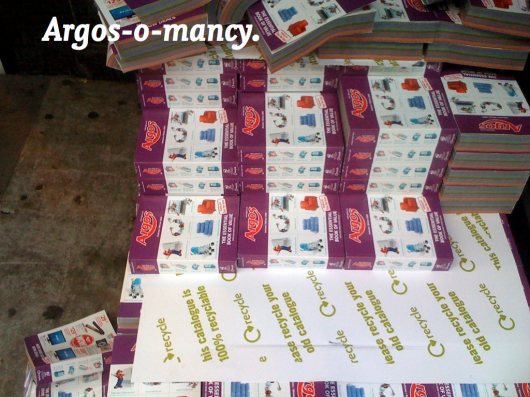
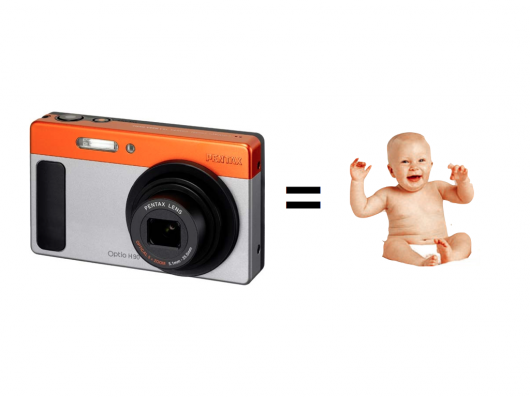
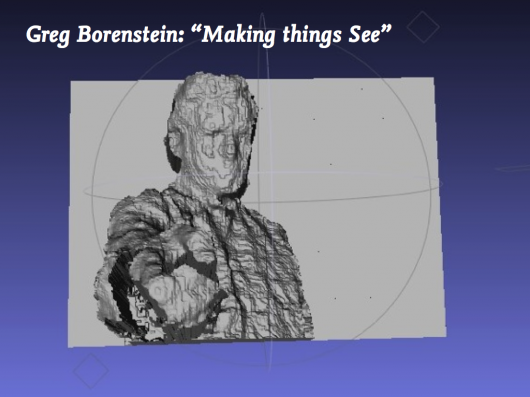
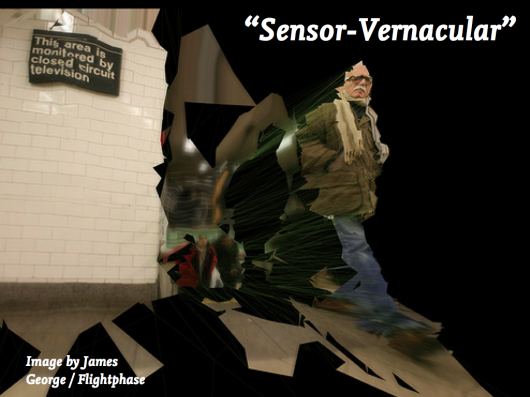

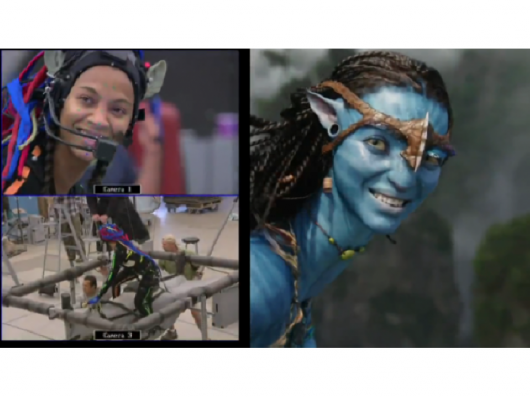



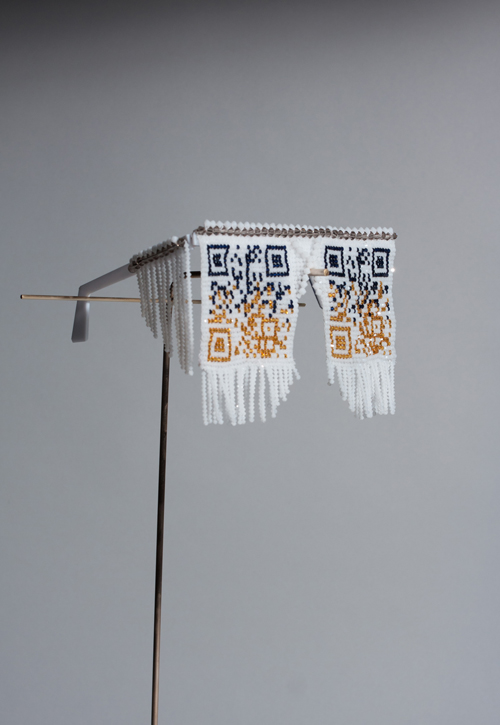
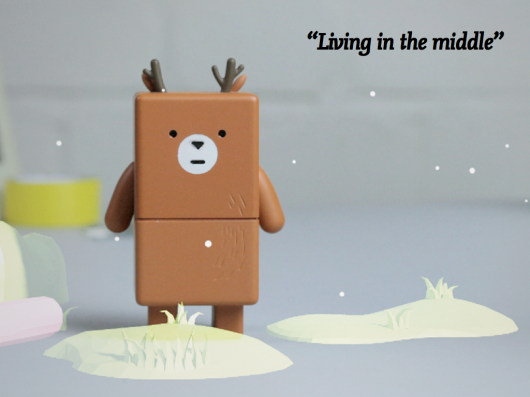
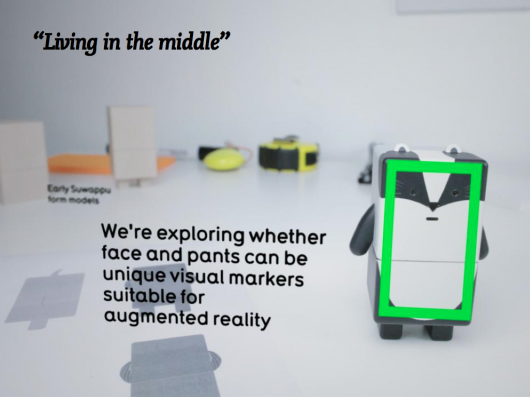
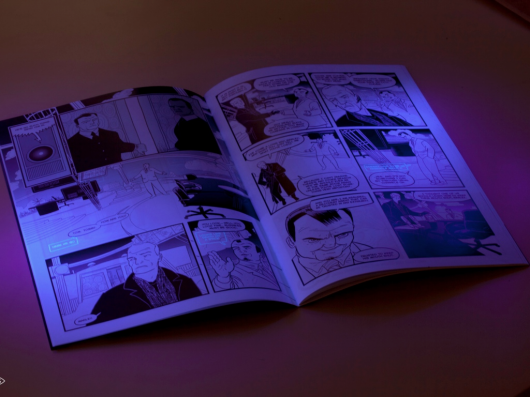

23 Comments and Trackbacks
1. Greg Borenstein said on 3 August 2011...
Great post, Matt. Insightful summary of the current state of play.
The bit I wonder about is the word “robot”. We’re definitely creating a world that’s covered in eyes connected to algorithms. And now we’re starting to double back around and teach the world to show off for these Seeing Algorithms. But calling these Seeing Algorithms “robots” feel anachronistic to me, like calling our satellite-connected pocket computers “phones”. I don’t think these Seeing Algorithms will necessarily take conventional embodied form in order to step into our world and act upon it. It’s much more likely that their area of action will be the digital inter-networked realm. These Seeing Algorithms regard our world not in order to create a classic 60s-era AI Plan of Action in order to move through it, but to convert it into information so that it can begin to bleed into their world. A better metaphor than a robot, might be the beam from Tron that scans people into the computer: http://www.urbanhonking.com/no/universe/Tron-Scan.jpg
2. Greg Borenstein said on 3 August 2011...
Addendum on further reflection:
Except, of course, the difference is that when Seeing Algorithms see us, they don’t disapparate our physical bodies. That’s the part where Tron becomes fantasy. Unlike Flynn, after being scanned we will co-exist doubly in both the physical and digital worlds. When our computers see us, they don’t pull us fully into their world, but instead create a kind of data shadow puppet of us there — whether that’s in the form of a series of government database entries tracking our movements through public space or a XBox avatar created by scanning and puppetting a 3D model of the user’s head. We’re designing systems that comprehend the user as both their physical bodies and these data puppets. And even when we don’t explicitly design for it that’s what we’re doing that’s who are users are. Users of mobile websites are also people standing somewhere in space and learning against something. The people who buy our bits of plastic and electronics are trailed by huge streams of data online and will want to see this product dip into that flow.
3. Greg Borenstein said on 3 August 2011...
(Here’s the Kinect face-scanned avatar link: http://3dsav.blogspot.com/2011/02/avatar-kinect-3d-scan-and-photo-map.html it’s an amazing demo.)
4. Chris said on 3 August 2011...
This will become interesting when folk know how to interact on this level – knitted QR codes, executable code selectively mown into lawns, Trojan Horses woven into supermarket displays by bored and disgruntled night staff to infect the cameraphones of equally disaffected customers.
5. Matt Jones said on 4 August 2011...
You’re quite right Greg – ‘Seeing Algorithms’ is a better unpacking of what we’re dealing with here, but not such a good headline 😉
I guess in the studio (and elsewhere I’m sure) we use ‘Bot’ as shorthand/catch-all for software with agency, so perhaps ‘Bot-Readable World’ would have been more honest, if not as alliterative!
6. Richard said on 4 August 2011...
Amazing tour – am a bit breathless and trying to digest it all. Thank you!
Something that I was wondering about was the way we react to these other eyes – how do our gestures and patterns of behaviour aid interaction with different intelligences? Is it going to be helpful for me to carry myself a certain way in front of the security camera if I want to get in to the office? Is there an advantage to me establishing a signature style of movement for the cameras, in the same way that I modulate my voice for different audiences? (And will security cameras feel patronised by my exaggeratedly-clear movements when they become more sophisticated?)
I had a scrambled go at describing this here – http://www.richardsandford.net/2011/01/17/robots-who-like-humans-who-like-humans-to-be-robots/ – after seeing a Nicki Minaj video: there’s something about the whole cut-up pop-and-lock style of certain performers that feels as if they’re reaching out to the editing software that creates their videos, saving the machines some time by putting on a mechanical accent. I suppose the opposite would be Adam Harvey’s CV Dazzle, which I think I might have seen in an earlier BERG post – http://cvdazzle.com/.
Anyway, wonderful summary of something coalescing that feels important to understand. Thanks very much.
7. Joerg said on 4 August 2011...
Great post Matt. It’s such a helpful way of looking at things – this other layer on top of our sensorial world. Thanks for sketching it out.
8. mclaren said on 5 August 2011...
You have to wonder what impact this will have on music and the arts. Will musical scores turn into robot-readable graphics? How about paintings? Or books?
9. TorchLight said on 7 August 2011...
“You have to wonder what impact this will have on music and the arts. Will musical scores turn into robot-readable graphics? How about paintings? Or books?”
I’m looking at the above from the typographic viewpoint,looking at hybrid fonts that speak to both robot and Humans…”fusing typography and symbology together to help solve the robot‘s question”
Where in the world am I?
10. Raimo said on 7 August 2011...
Matt,
Yes yes yes.
Looks like you are going down the same rabbit hole. I tried out a talk in may this year about the birth of the Digital Eye. In this talk I touch the light switch theory, predation and anti-predation mechanisms. Here is the link: http://site.layar.com/company/blog/the-birth-of-the-digital-eye/
I take it to slightly different place around transparency and our relationship with corporations. I didn’t yet dare to touch a world with things in the middle.
Looking forward to meet you again somewhere.
11. Matt Jones said on 8 August 2011...
Hi Raimo! I hadn’t seen that talk. Interesting stuff, good to see you reference the light-switch mechanism! See you somewhere soon too!
Trackback: 'We're in a present where a £100 point-and-shoot camera has the approximate empathic capabilities of a infant,' @ Sore Eyes 10 August 2011
[…] 2011Matt Jones has posted a summary of a recent talk he gave pulling together his thoughts about The Robot-Readable World.Robot-Readable World is a pot to put things in, something that I first started putting things in […]
Trackback: YOUrban — Noticing the city 6 October 2011
[…] products, advertising, photography and so on. It reminded us that we are increasingly living in a robot-readable world. Infrastructural […]
Trackback: Questions About 'The New Aesthetic' | Noble Imaging, LLC 1 November 2011
[…] like Matt Jones are doing a lot of work on the visual aspects of the New Aesthetic’s ”robot-readable world“ and the increasing number of ways in which computer vision shapes the way we see things. […]
Trackback: O Danny Boy | My Favorite Design Articles 2011 27 November 2011
[…] The Robot-readable World, Matt Jones Computer vision is a deep, dark specialism with strange opportunities and constraints. The signals that we design towards robots might be both simpler and more sophisticated than QR codes or other 2d barcodes. […]
Trackback: Drone Landscapes, Intelligent Geotextiles, Geographic Countermeasures | Tainted Stream 26 January 2012
[…] effect, this would terrestrialize the so-called robot-readable world: burying the signs and sensors that such machines require and disguising them in apparently natural […]
Trackback: Jasonmcdermott » 1% of 1% 1 February 2012
[…] will accept that there are some really good examples of QR codes doing interesting things – but that’s about it. Toys for smartphone users (like myself) […]
Trackback: A Ship Adrift | booktwo.org 9 February 2012
[…] that others have been pointing at too, in Kevin Slavin’s algotremors, in BERG’s robot-readable world, in Timo‘s beautifully compelling compilation of machine […]
Trackback: Optical Calibration Targets « Random Ramblings of Rude Reality 15 February 2013
[…] nothing, they are now just curious emblems of a previous generation of surveillance technology, robot-readable hieroglyphs whose machines have all moved […]
Trackback: Optical Calibration Targets | i like this art 17 February 2013
[…] nothing, they are now just curious emblems of a previous generation of surveillance technology, robot-readable hieroglyphs whose machines have all moved on. – via […]
Trackback: Optical Calibration Targets | Nick Socrates Contemporary Art 17 February 2013
[…] nothing, they are now just curious emblems of a previous generation of surveillance technology, robot-readable hieroglyphs whose machines have all moved on. – via […]
Trackback: Telling stories to our computers 12 March 2013
[…] idea of the robot-readable world has been bubbling away for a few years now. In the previous article in this series, I touched on […]
Trackback: Fashion + the New Aesthetic (2.1) | HAUTEPOP 23 March 2013
[…] explorations, one way or another, of a “robot readable world”. The designer Matt Jones asked, “What if, instead of designing computers and robots that relate to what we can see, we meet them […]